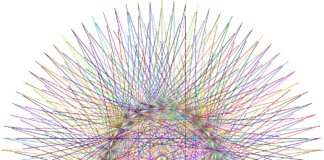Bacterial Computing: Unveiling the Potential of Microbial Logic
In the realm of unconventional computation, where creativity meets science, a groundbreaking concept has emerged — Bacterial Computing. This novel approach harnesses the remarkable capabilities of living organisms, specifically bacteria, to perform computation and solve complex problems. At the intersection of biology and computer science, bacterial computing introduces a new paradigm that holds promise for various applications ranging from environmental monitoring to bioengineering.
Bacterial computing redefines our understanding of computation by tapping into the intrinsic behaviors and interactions of bacterial colonies. Unlike traditional electronic computers that rely on silicon-based processors, bacterial computing employs the natural information processing abilities of bacteria to perform specific tasks. This nascent field rests on the foundation that bacterial cells can process information, communicate with each other, and exhibit collective behavior, all of which can be harnessed for computational purposes.
The fundamental principle of bacterial computing revolves around utilizing the inherent characteristics of bacteria, such as their ability to sense environmental cues, communicate through signaling molecules, and exhibit intricate group dynamics. These attributes are harnessed to create bio-logical gates, analogous to electronic logic gates, but built from bacterial cells. These bacterial logic gates serve as the building blocks for constructing bacterial circuits, where the interactions between bacterial colonies lead to the execution of computational tasks.
At the core of bacterial computing lies the concept of quorum sensing, a communication mechanism employed by bacteria to coordinate their behavior based on population density. Quorum sensing involves the secretion and detection of signaling molecules, allowing bacteria to assess the local density of their peers. By engineering bacterial strains with specific genetic circuits, researchers can program bacteria to respond to these signaling molecules in predetermined ways. This capability forms the basis for constructing AND, OR, NOT, and other logic gates using bacterial cells.
To achieve complex computations, these bacterial logic gates are interconnected, mirroring the architecture of traditional digital circuits. The interactions between bacterial colonies, each acting as a logic gate, create a cascade of signals that ultimately result in the desired computational output. The ability to engineer bacterial strains with precision offers control over the computational processes, allowing for the execution of algorithms using bacterial computing platforms.
Bacterial computing’s potential applications span across various domains. One of the most prominent applications is environmental monitoring. By leveraging bacteria’s sensitivity to specific environmental cues, such as pollutants or toxins, bacterial computing systems can be designed to detect and signal the presence of these substances. These systems could revolutionize environmental monitoring by offering real-time, self-sustaining, and cost-effective solutions for pollution detection in soil, water, and air.
Furthermore, bacterial computing holds great promise in the realm of bioengineering. Synthetic biology, an interdisciplinary field that combines biology and engineering, has paved the way for designing and constructing novel biological systems. Bacterial computing can complement this approach by enabling the creation of living devices that can process information and respond to changing conditions within the body. For instance, researchers envision using bacterial computing to engineer probiotics that can sense and respond to the presence of specific molecules in the gut, offering personalized therapeutic interventions.
As with any groundbreaking concept, bacterial computing also presents challenges. Ensuring the reliability and stability of bacterial computing systems is a crucial concern. Bacterial colonies are influenced by factors such as genetic mutations, environmental fluctuations, and intercellular variability, which can impact the accuracy of computation. Researchers are working to develop strategies to mitigate these challenges and enhance the robustness of bacterial computing platforms.
In conclusion, bacterial computing stands as a testament to the innovative merging of biology and computer science. By harnessing the inherent capabilities of bacterial colonies, this emerging field offers a new approach to computation with applications that extend from environmental monitoring to bioengineering. While challenges remain, the potential benefits of bacterial computing are undeniable, shaping a future where living organisms contribute to computational processes in unprecedented ways.
Bacterial computing, at its core, embodies a harmonious fusion of two seemingly disparate realms: the microcosmic world of living organisms and the macrocosmic world of digital computation. This extraordinary marriage of biology and computer science opens doors to unconventional pathways of problem-solving and information processing that were once deemed inconceivable.
In the pursuit of pushing the boundaries of computation, researchers found inspiration in the natural world. Bacteria, those minuscule single-celled organisms that have populated Earth for billions of years, exhibit behaviors and traits that piqued the curiosity of scientists. While they lack the sophistication of human-made computers, bacteria possess an innate ability to communicate, adapt, and self-organize, all attributes that serve as the building blocks of bacterial computing.
At the heart of bacterial computing lies the concept of quorum sensing, a communication mechanism that bacteria employ to gauge their population density. Through this mechanism, bacteria release signaling molecules, the concentration of which acts as a molecular vote count. Once a threshold concentration is reached, a response is triggered, akin to a democratic decision being made. This concept has been exploited by researchers to design logic gates in bacterial computing systems. By engineering bacteria to release and respond to these signaling molecules, intricate circuits can be constructed, enabling information processing through collective bacterial behaviors.
The simplicity of bacterial computing belies its potential complexity. While traditional computers consist of intricate silicon-based transistors, bacterial computing involves the orchestration of bacterial colonies, each akin to a microchip executing a specific logic function. The interactions between these colonies simulate the interconnectivity of electronic circuits. This mimicry of electronic architecture with living entities demonstrates the versatility of biological systems in emulating functions traditionally reserved for inanimate materials.
The convergence of bacterial computing and environmental monitoring has sparked particular interest. The natural sensitivity of bacteria to environmental changes, combined with the programmability of their responses, has laid the foundation for ecological applications. Imagine a scenario where bacterial computing systems are strategically placed in ecosystems to detect pollutants, toxins, or even indicators of climate change. These living sensors, attuned to minute changes in their surroundings, could transmit real-time data that informs decision-making for conservation efforts and pollution management.
The prospect of harnessing bacterial computing for healthcare introduces yet another dimension of possibilities. As the field of personalized medicine gains momentum, bacterial computing’s role becomes more evident. Consider the potential of bacteria modified to respond to specific molecules associated with diseases. These living diagnostics could be introduced into the body to provide early warnings of pathological conditions, revolutionizing disease detection and prevention. The symbiotic relationship between bacterial computing and medical science underscores the cross-disciplinary nature of this paradigm.
Ethical considerations inevitably arise in the face of these transformative concepts. As bacterial computing advances, questions about the ethical treatment of living computing entities come to the forefront. Should bacteria be considered mere tools, or do they warrant a distinct ethical status due to their life-like attributes? Striking a balance between scientific progress and responsible stewardship of life raises vital debates that need to be navigated as this field evolves.
The very notion of bacterial computing challenges our perception of computation itself. The silicon circuits that have driven the digital age are contrasted with living, breathing bacterial colonies functioning as logic gates. This contrast highlights the malleability of computation and expands the horizons of what can be considered a computing substrate. Bacterial computing’s reliance on biological processes rather than electronic currents introduces a new form of computation, one that aligns with the organic underpinnings of life.
Despite its novelty, bacterial computing does not exist in isolation. It dovetails with ongoing research in synthetic biology, genetic engineering, and nanotechnology. These interdisciplinary connections amplify its potential impact, extending its reach into diverse domains. From creating bio-hybrid systems that merge living cells with synthetic components to engineering bacteria to produce biofuels, the versatility of bacterial computing ripples through modern science and industry.
The progression of bacterial computing is not without challenges. While bacteria hold immense potential, they are inherently variable and sensitive to external factors. Genetic mutations, environmental fluctuations, and the inherent variability of biological systems can introduce uncertainties into computational processes. Addressing these challenges requires a combination of genetic engineering expertise, algorithmic design, and a deep understanding of bacterial behaviors.
In the grand tapestry of scientific advancement, bacterial computing emerges as a brilliant thread weaving together the fabric of life and computation. It celebrates the intricate elegance of biology while embracing the logical rigor of computer science. As this field advances, it beckons researchers, ethicists, and visionaries to collectively shape its trajectory. Bacterial computing is not merely a technological leap; it is a philosophical exploration of the interplay between the organic and the synthetic, the microscopic and the macroscopic. With each breakthrough, we inch closer to unraveling the full spectrum of possibilities that bacterial computing holds for our world and beyond.
Bacterial computing, a realm where the tiniest forms of life become the architects of complex computational processes, unfurls a narrative that resonates at the intersection of scientific curiosity and technological innovation. In this intricate tapestry of exploration, the boundaries of what defines computation are pushed, reshaped by the very essence of life itself.
Consider for a moment the profound implications of bacterial computing on our perception of life’s role in the digital age. Throughout human history, the act of computation has been relegated to machines, devices of human invention designed to process information at lightning speed. Yet, bacterial computing challenges this status quo by positing that life forms, often relegated to the realm of biology, can possess computational prowess.
Embedded within the core of bacterial computing is the notion that the principles governing life can be co-opted to serve as the guiding principles for computation. This paradigm shift ripples through the annals of science, inviting us to rethink the essential attributes of living organisms and their capacity to influence the digital landscape. By engaging bacteria, these ancient and humble life forms, as active participants in computation, we bestow upon them a role that extends beyond their traditional biological functions.
The synergy between bacterial computing and evolutionary biology is particularly intriguing. Evolution has sculpted life on Earth, endowing organisms with the genetic makeup that bestows survival advantages. Bacteria, existing at the forefront of life’s diversity, have demonstrated their adaptability over eons, honing strategies for survival. Now, in the context of bacterial computing, these adaptive traits are repurposed. Bacteria that once evolved to thrive in specific environments now evolve to process information and perform computations, casting evolution itself as an algorithmic process.
The dynamic relationship between bacteria and their environment mirrors the broader dance of existence. Bacterial colonies, much like civilizations, depend on effective communication and cooperation to thrive. As bacterial computing taps into these interconnections, it underscores the symphonic nature of life, where individual agents harmonize to create emergent patterns of behavior. The metaphor of bacterial colonies as tiny societies endowed with computational power invites us to contemplate the parallels between biological and social systems.
On a philosophical canvas, bacterial computing ushers in discussions about the nature of intelligence. In the realm of artificial intelligence, we have strived to replicate human cognitive processes in machines. Bacterial computing, in contrast, opens a portal to an entirely different kind of intelligence—a biological intelligence that is shaped by evolution’s tinkering. It beckons us to broaden our definition of intelligence, acknowledging the myriad ways in which information can be processed and harnessed for problem-solving.
The duality of bacterial computing’s simplicity and complexity is a testament to the enigma of life itself. Bacteria, with their minuscule size and straightforward genetic makeup, are the embodiment of simplicity. Yet, as they engage in intricate signaling, respond to stimuli, and execute computational functions, they unveil layers of complexity that underscore the elegance of nature’s design. Bacterial computing invites us to peer into this interplay of simplicity and complexity, fostering a deeper appreciation for the fundamental essence of life.
At the heart of bacterial computing is a whisper of harmony with nature. As the world grapples with the consequences of human activities on the environment, bacterial computing presents an alternative narrative. It whispers of a future where technology and biology collaborate in ways that echo the symbiotic relationships found in ecosystems. By harnessing bacterial capabilities for computation, we glimpse a path towards sustainable innovation, where the principles of life itself guide technological progress.
The trajectory of bacterial computing converges with the tales of pioneering scientific inquiry. From the discovery of bacterial quorum sensing to the engineering of living circuits, this narrative traces the footsteps of scientists who, armed with curiosity and creativity, venture into uncharted territories. Bacterial computing exemplifies the scientific spirit—a quest for understanding that transcends disciplinary boundaries and blurs the lines between the expected and the extraordinary.
As we navigate the intricacies of bacterial computing, we grapple with ethical questions that transcend laboratory walls. The manipulation of life, even at the microscopic scale, prompts contemplation on the ethical responsibilities that accompany such power. The fusion of biology and computation calls for a nuanced approach to ethics, one that navigates the terrain between technological progress and the reverence for life.
In essence, bacterial computing is more than a technological pursuit; it’s a narrative that weaves together the threads of biology, computation, philosophy, and ethics. It challenges us to reimagine the relationships between living organisms and technology, inviting us to reconsider the boundaries that delineate life from non-life and the organic from the synthetic. Bacterial computing is a canvas upon which science and imagination collaborate, painting a portrait of a future where the tiniest beings partake in the grand tapestry of human innovation.














